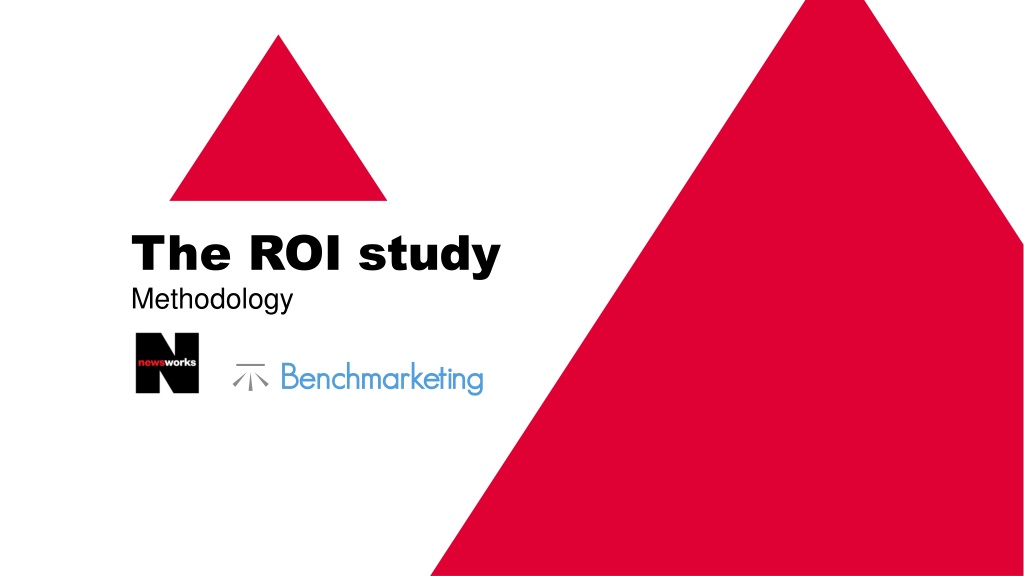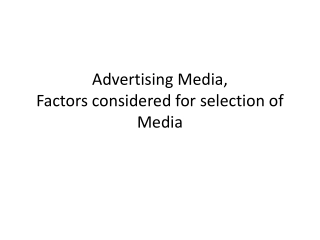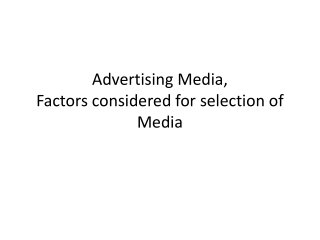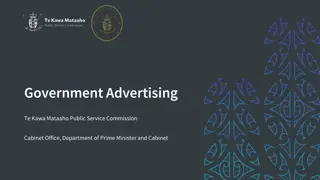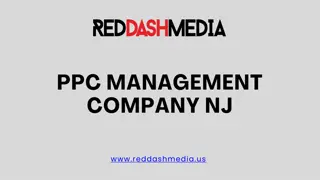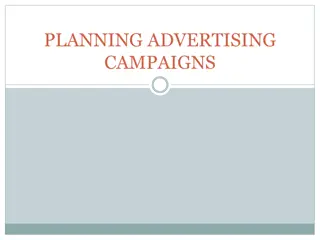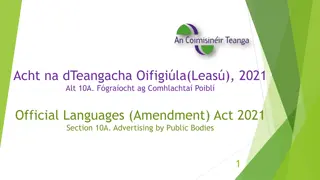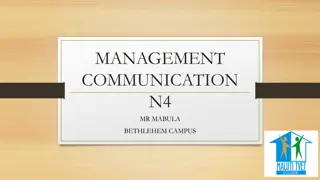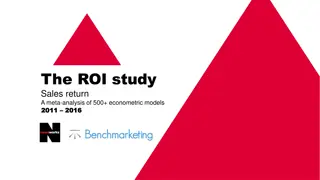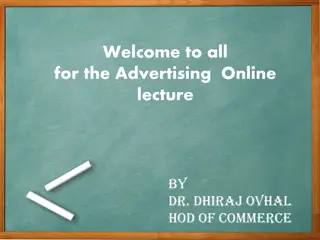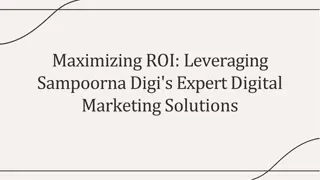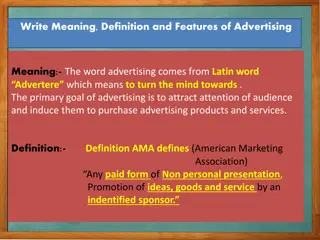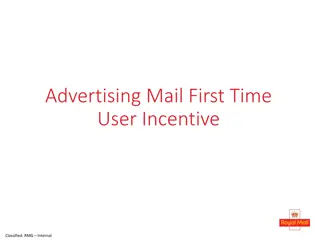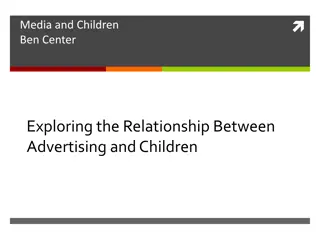Understanding the ROI Study Methodology in Advertising Research
Explore the methodology behind ROI studies in advertising effectiveness, led by Sally Dickerson. Learn about budget optimization, econometric models, media mix analysis, and the role of econometrics in identifying sales-driving factors.
Download Presentation

Please find below an Image/Link to download the presentation.
The content on the website is provided AS IS for your information and personal use only. It may not be sold, licensed, or shared on other websites without obtaining consent from the author. Download presentation by click this link. If you encounter any issues during the download, it is possible that the publisher has removed the file from their server.
E N D
Presentation Transcript
The ROI study Methodology
The ROI study The ROI study Analysis conducted by Sally Dickerson, managing director of effectiveness consultancy Part of the Omnicom Media Group A graduate in Mathematics from Oxford, Sally joined Mars UK as a market research analyst, later joining their Management Science division. She co-founded The Decision Shop, part of Bates/Cordiant then in 1999 joined the then OMD group and set up ROI (Return on Investment) focused on market mix modelling, which became OMD Metrics, then BrandScience, and is now Annalect Marketing Sciences. In 2016 Sally created a new consultancy business, Benchmarketing, running strategic quantitative consultancy projects using meta analysis. She has also contributed to over 30 IPA advertising effectiveness awards, been an IPA effectiveness award judge, and run marketing effectiveness masterclasses for the Marketing Society and Chartered Institute of Marketing. She was a judge on the inaugural Cannes Creative Effectiveness Lions panel, in 2011 and again in 2013.
The ROI study: methodology The ROI study: methodology 1 1 Advertising spend data2 2 3 3 Budget optimisation A meta analysis of econometric models
The ROI study: methodology The ROI study: methodology 1 1 Advertising spend data
SMI data provides a representative SMI data provides a representative picture of actual media mix picture of actual media mix Actual media spend from booking data provided by 65% of UK agencies Detailed breakdown of digital spend across display, video and paid search Data across all above the line media Breakdown of newsbrand spend across print and digital Source: SMI (Standard Media Index)
The ROI study: methodology The ROI study: methodology 2 2 A meta analysis of econometric models
Econometrics Econometrics identifying and assigning a weight to the identifying and assigning a weight to the ingredients driving sales ingredients driving sales Advertising x medium and message Advertising x medium and message PR, Media mentions, Buzz PR, Media mentions, Buzz Pricing Pricing vs vs competitors competitors Store universe changes Store universe changes Product/Range changes Product/Range changes Brand awareness/perceptions Brand awareness/perceptions Competitor marketing Competitor marketing Competitor routes to market Competitor routes to market Technological change Technological change Seasonality Seasonality Economic change Economic change
Calculating Revenue Return on Investment (RROI) Calculating Revenue Return on Investment (RROI) We isolate and quantify drivers of sales. This chart is a very simplified illustration of that, showing the sales pattern over time broken down by the different drivers, in this case a combination so enabling calculation of Revenue return on media investment Calculating revenue return on investment (RROI) Sales m due to spend Base Channel 2 Distribution 1 Channel 3 Distribution 2 Channel 4 Promotions Channel 5 Channel 1 Spend m RROI Channel 1 3.0 2.5 1.20 Channel 2 0.5 0.5 1.00 Channel 3 Channel 4 3.0 1.5 2.00 1.5 1.0 1.50 Channel 5 Total 0.6 0.5 1.20 8.6 6.0 1.43
A meta analysis of econometric models A meta analysis of econometric models Meta analysis is analysis of analysis results the meta data It s common in pharmaceuticals, clinical drugs trials One trial isn t enough, you need hundreds so as to be sure of your results If all the trials come up with the same answer, that s a very strong result If the trial results are different, then being able to explain robustly why they are different different dosage, different demographic sample - is again a result and new learning Using our cake analogy we can work out whether better tasting cakes always use butter rather than margarine in the recipe, and whether using three eggs works better than two
Defining the relationship between spend and Defining the relationship between spend and revenue return revenue return Scatter graphs allow us to see relationships in data. Here in this example chart, used for illustration, we can see the relationship between media spend and revenue return. Specifically looking at print newsbrands Percentage of total comms spend and the revenue ROI. Each dot on the graph represents an econometric model case in the Results Vault. Here the data suggests as the % of print newsbrands in the mix increases, so does effectiveness 1.6 1.4 R = 0.9556 1.2 1.0 Revenue ROI Revenue ROI 0.8 0.6 0.4 0.2 0.0 0% 20% 40% 60% 80% 100% Print newsbrands % of total communications spend Print newsbrands % of total communications spend This is an example chart, not real data
Creating tertile groups of cases shows the revenue return for low, medium and high spend levels In order to see the relationship more clearly, we create tertile groups of case, according to their print newsbrand spend as a % of the overall media mix. This creates robust groups, on which we can report the average Y axis score for each group - i.e. the average Revenue ROI 1.6 1.4 1.2 1.0 Revenue ROI Revenue ROI 0.8 0.6 0.4 0.2 0.0 0% 10% 20% 30% 40% 50% 60% 70% 80% 90% 1.5 % of total communications spend % of total communications spend 1.0 0.5 0.0 Tertiles Tertiles of % of total communications spend of % of total communications spend This is an example chart, not real data
2015 spend levels 16.5% Retail So to see this in action, let s look at the retail category. In this case we have added a fourth group no print newsbrand spend. We can then compare the three tertiles of newsbrand spend to the group with no spend. 25.18 18.82 18.25 Total campaign revenue 9.08 ROI In Retail: Print newsbrands boost total campaign ROI by 2.8 times, with the optimum return when they are 20% to 31% of the mix. High 31-100% Medium 20-31% No print newsbrand spend Low 2-20% In all cases it is always better to have print newsbrands in the mix. Print newsbrand % of total campaign spend in retail Source: Benchmarketing/Brand Science Results Vaults 2011 to 2015 excludes outliers and incomplete models
The ROI study: methodology The ROI study: methodology 3 3 Budget optimisation
Budget optimisation 1 Budget optimisation 1 The data from the meta analysis allows us to build response curves for each media channel 900 This works by analysing ROIs across data points in each category to generate average response curves Online Display TV Online Search Curves that go flat suggest high diminishing returns and no benefits to spending, unless that curve is flat and above all others Newspapers VOD Revenue m Outdoor We can take an annual budget and optimise the overall ROI for the spend, by changing the mix Magazines Radio TV Sponsorship It s a simple hill-climbing optimisation that picks the highest and the slopi-est points by medium Cinema 0 80 Media investment m From the curves we can calculate the optimum media split for any given budget Source: Benchmarketing/Brand Science Results Vaults 2011 to 2015 excludes outliers and incomplete models
Budget optimisation 2 Budget optimisation 2 Recommended spend in print newsbrands would be double current FMCG level of 5% for food and drink brands Recommended print newsbrand % for optimal campaign ROI 20% 16% 13% 12% 12% 11% 11% 10% 10% 10% 1 2 3 4 5 6 7 8 9 10 Annual spend m
